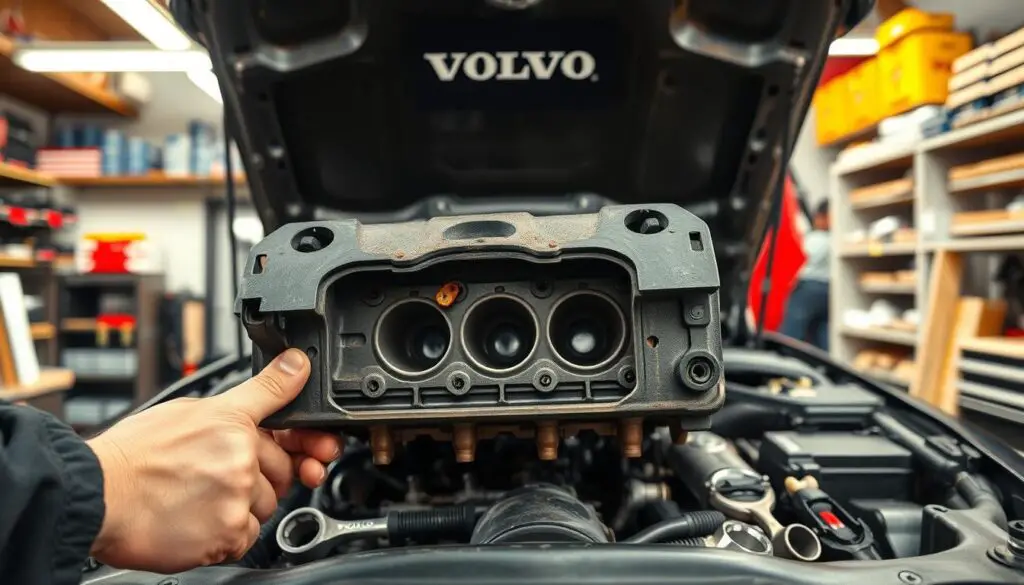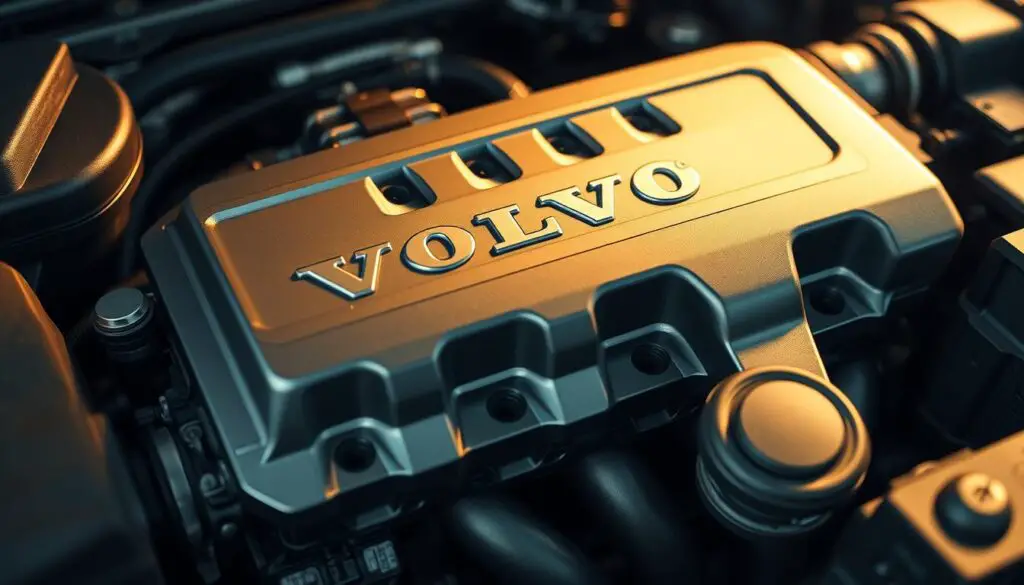Maintaining your Volvo is crucial for its longevity and performance. One critical aspect of this maintenance is understanding the valve cover gasket replacement cost. A failing gasket can lead to leaks, decreased engine performance, and potentially costly repairs if not addressed promptly.
Recognizing the signs of a failing gasket and knowing how to replace it can save you money and ensure your Volvo runs smoothly. This guide will walk you through the process, providing insights into the replacement cost and a step-by-step DIY guide.
Key Takeaways
- Understanding the signs of a failing valve cover gasket.
- Learning the DIY process for gasket replacement.
- Estimating the total cost of replacement.
- Tips for maintaining your Volvo’s engine health.
- Factors influencing the valve cover gasket replacement cost.
Understanding Valve Cover Gaskets in Volvo Engines
A well-functioning valve cover gasket is fundamental to maintaining the health of your Volvo engine. The valve cover gasket plays a crucial role in sealing the valve cover to the engine cylinder head, preventing oil leaks and ensuring that the engine operates smoothly.
Function and Importance of Valve Cover Gaskets
The primary function of a valve cover gasket is to seal the valve cover, preventing engine oil from leaking out. This gasket is essential for maintaining the integrity of the engine’s lubrication system. A faulty valve cover gasket can lead to oil leaks, decreased engine performance, and potentially cause damage to other engine components.
Common Materials Used in Volvo Gaskets
Volvo gaskets are typically made from materials such as rubber, silicone, or composite materials. The choice of material depends on the specific engine design and the operating conditions of the gasket. For instance, some Volvo models may use gaskets made from high-temperature resistant materials to withstand the engine’s heat.
Engine Design Variations in Volvo Models
Volvo offers a range of engine designs across its model lineup, from inline-4 to inline-6 and V8 engines. Each engine design has its unique characteristics and requirements for the valve cover gasket. Understanding these variations is crucial for selecting the correct replacement gasket and ensuring proper engine performance.
Signs of a Failing Valve Cover Gasket
Identifying the early warning signs of a failing valve cover gasket is crucial for Volvo owners to prevent further engine damage. A valve cover gasket failure can lead to a range of issues, from minor annoyances to major engine problems.
Oil Leaks on Engine Surface
One of the most common signs of a failing valve cover gasket is oil leakage on the engine surface. If you notice oil droplets or a puddle forming around the valve cover area, it’s likely that the gasket is compromised.
Burning Oil Smell and Smoke
A burning oil smell, often accompanied by smoke, is another indicator of a failing valve cover gasket. This occurs when oil leaks onto hot engine components, causing the oil to burn.
Decreased Engine Performance
A failing valve cover gasket can also lead to decreased engine performance. As the gasket fails, it can allow oil to enter areas it shouldn’t, potentially causing issues with engine operation.
Check Engine Light Warnings
In many cases, a failing valve cover gasket will trigger the check engine light on your dashboard. This is often due to the engine control module detecting issues related to the gasket failure.
| Sign | Description |
|---|---|
| Oil Leaks | Visible oil droplets or puddles around the valve cover |
| Burning Smell | Oil leaking onto hot engine components, causing a burning smell |
| Decreased Performance | Engine performance issues due to oil entering incorrect areas |
| Check Engine Light | Dashboard warning light indicating engine issues related to gasket failure |
Volvo Valve Cover Gasket Replacement Cost Breakdown
Understanding the breakdown of costs for Volvo valve cover gasket replacement is crucial for budgeting. The total expense involves several components, including the cost of parts and labor.
OEM vs. Aftermarket Parts Pricing
The cost of the valve cover gasket itself can vary significantly depending on whether you choose an Original Equipment Manufacturer (OEM) part or an aftermarket alternative. OEM parts are typically more expensive, offering the assurance of quality and compatibility. For instance, an OEM valve cover gasket for a Volvo can range from $50 to $150. In contrast, aftermarket parts can be more affordable, priced between $20 to $70, but may vary in quality.
Labor Cost Factors
Labor costs are another significant factor in the overall expense. The complexity of the job and the mechanic’s hourly rate determine labor costs. For Volvo models, labor costs can range from $200 to $500, depending on the workshop’s hourly rate, which can vary from $75 to $150 per hour.
Dealership vs. Independent Shop Pricing
Dealerships typically charge more than independent repair shops. At a dealership, the total cost, including parts and labor, can be 10% to 20% higher. Independent shops may offer more competitive pricing, potentially saving you 15% to 30% on the total bill.
Regional Price Variations in the United States
Regional variations also play a role in the cost. Urban areas, particularly on the East and West Coasts, tend to have higher labor rates compared to rural areas. For example, replacing a valve cover gasket in a major city like New York or Los Angeles might cost 10% to 25% more than in smaller towns or cities in the Midwest.
Cost Variations Across Different Volvo Models
Different Volvo models have distinct engine configurations, leading to variations in valve cover gasket replacement costs. Understanding these differences is crucial for Volvo owners to budget accurately for maintenance and repairs.
4-Cylinder Models (S60, V60, XC40)
For Volvo’s 4-cylinder models like the S60, V60, and XC40, the valve cover gasket replacement cost tends to be on the lower end of the spectrum. This is primarily due to the simpler engine design and fewer components involved.
6-Cylinder Models (S90, XC60)
Volvo’s 6-cylinder models, including the S90 and XC60, typically have a higher valve cover gasket replacement cost. The increased complexity of the 6-cylinder engine, with more cylinders and potentially more advanced technology, contributes to the higher cost.
8-Cylinder and Specialty Engines
The 8-cylinder and specialty engines found in some Volvo models represent a higher end of the cost spectrum for valve cover gasket replacement. These engines often feature more complex designs and may require specialized tools, increasing labor costs.
Older Volvo 5-Cylinder Engines
Older Volvo models equipped with 5-cylinder engines present a unique case. While some parts may be less expensive due to being older, the labor cost can be higher due to the complexity and less commonality of these engines, potentially balancing out the overall cost.
| Volvo Model | Engine Type | Approximate Replacement Cost |
|---|---|---|
| S60 | 4-Cylinder | $500-$800 |
| S90 | 6-Cylinder | $700-$1,200 |
| XC40 | 4-Cylinder | $500-$800 |
| XC60 | 6-Cylinder | $700-$1,200 |
| Older 5-Cylinder | 5-Cylinder | $600-$1,000 |
It’s essential for Volvo owners to consult with a professional mechanic to get a more accurate estimate based on their specific vehicle’s make, model, and year.
Tools and Materials Needed for DIY Replacement
When embarking on a DIY valve cover gasket replacement, having the right tools and materials is crucial for success. This task requires a combination of general hand tools, specialized Volvo tools, and high-quality gaskets and sealants.
Essential Hand Tools
A basic set of hand tools is necessary for any DIY repair. For a valve cover gasket replacement, you’ll need socket sets, wrenches, and Torx drivers. “A good set of tools is an investment that pays off in the long run,” as many DIY enthusiasts attest. Having the correct sizes and types of these tools ensures that you can remove and replace the necessary components without damaging them.
Specialized Volvo Tools
Volvo-specific tools can simplify the process and prevent damage to your vehicle’s engine. These may include a valve cover removal tool and a torque wrench. Using the correct specialized tools can make a significant difference in the ease and quality of the replacement.
Recommended Gasket Brands and Types
Choosing the right gasket is critical for a successful replacement. Popular brands for Volvo valve cover gaskets include Elring, Victor Reinz, and SKF. It’s essential to select a gasket that matches your Volvo’s specifications.
Sealants and Cleaning Supplies
In addition to the gasket itself, you’ll need sealants and cleaning supplies to ensure a proper seal and clean surfaces. A good quality sealant can help prevent leaks, while cleaning supplies like brake cleaner and lint-free rags are necessary for preparing the surfaces.
Preparing Your Volvo for Valve Cover Gasket Replacement
Before diving into the valve cover gasket replacement process, it’s crucial to prepare your Volvo properly. This preparation ensures a smooth and safe DIY experience.
Safety Precautions
First and foremost, safety should be your top priority. Ensure you wear protective gear, including gloves and safety glasses, to protect yourself from potential hazards.
Engine Cooling Requirements
Allow your Volvo’s engine to cool down completely before starting the replacement. A cool engine prevents burns and ensures a safe working environment.
Disconnecting the Battery
To avoid any accidental engine starts or electrical shocks, disconnect the battery before beginning the replacement process. This is a critical safety step that should not be overlooked.
Workspace Setup and Organization
Organize your workspace by gathering all necessary tools and materials within easy reach. A clean and organized workspace, as emphasized by experts, “significantly reduces the risk of errors and improves efficiency”

Step-by-Step DIY Valve Cover Gasket Replacement
Understanding how to replace the valve cover gasket is essential for any Volvo owner looking to maintain their vehicle’s performance and prevent oil leaks. This guide will walk you through the process, ensuring you have the knowledge to complete this crucial maintenance task.
Removing Engine Covers and Components
The first step in replacing your Volvo’s valve cover gasket is to remove the engine covers and any other components that obstruct access to the valve cover. This typically includes plastic covers and possibly some brackets, depending on your Volvo model.
- Use a socket set to remove the bolts holding the covers in place.
- Gently pry the covers off, taking care not to damage any of the surrounding components.
- Set the covers and bolts aside in a safe place for reassembly later.
Disconnecting Electrical Connections
Before you can access the valve cover, you’ll need to disconnect any electrical connections in the area. This may include spark plug wires, sensors, or other components.
- Identify the connections that need to be disconnected.
- Use the appropriate tools to release the connectors.
- Carefully move the disconnected wires and connectors out of the way.
Removing the Valve Cover
With the engine covers and electrical connections out of the way, you can now remove the valve cover. Use a socket or wrench to remove the bolts around the perimeter of the cover.
Cleaning Surfaces and Installing New Gasket
Cleaning the surfaces around the valve cover area is crucial for ensuring a proper seal with the new gasket.
Surface Preparation Techniques
Use a gasket scraper or a razor blade to remove any remaining gasket material or debris. Ensure the surface is clean and dry before proceeding.
Gasket Positioning and Alignment
Carefully place the new gasket onto the valve cover, ensuring it’s properly aligned with the bolt holes.
Proper Torque Sequence and Specifications
When reassembling, it’s critical to follow the proper torque sequence and specifications for the valve cover bolts to ensure a leak-free seal.
“Proper torque sequence is crucial for preventing leaks and ensuring the longevity of the gasket.”
Reassembly Process
Reassemble everything in the reverse order that it was removed. Make sure to reconnect all electrical connections and replace any engine covers.
By following these steps, you can successfully replace your Volvo’s valve cover gasket, ensuring your engine remains in good health.
Common Mistakes to Avoid During Replacement
When replacing a Volvo valve cover gasket, several common mistakes can lead to costly rework or further engine damage. Being aware of these potential pitfalls can help DIYers achieve a successful repair.
Improper Torque Applications
One of the most critical aspects of valve cover gasket replacement is applying the correct torque to the bolts. Improper torque can lead to gasket failure or damage to the valve cover. Always refer to your Volvo’s repair manual for the specified torque sequence and values.
Surface Preparation Errors
Proper surface preparation is essential for a leak-free seal. Failing to clean the mating surfaces thoroughly can result in gasket failure. Ensure that all old gasket material and debris are removed before installing the new gasket.
Gasket Alignment Issues
Correctly aligning the gasket with the valve cover and cylinder head is crucial. Misalignment can cause the gasket to be pinched or damaged, leading to leaks. Take your time to ensure the gasket is properly seated.
Reusing Old Hardware
Reusing old bolts or other hardware can be tempting, but it’s not recommended. Old bolts may be stretched or damaged, compromising the integrity of the repair. Always use new hardware when recommended by the manufacturer.
| Common Mistake | Consequence | Prevention |
|---|---|---|
| Improper Torque | Gasket failure or valve cover damage | Follow manufacturer’s torque specs |
| Surface Preparation Errors | Leaks due to poor sealing | Thoroughly clean mating surfaces |
| Gasket Alignment Issues | Gasket damage or pinching | Carefully align gasket during installation |
| Reusing Old Hardware | Compromised repair integrity | Use new hardware as recommended |
By avoiding these common mistakes, DIYers can ensure a successful valve cover gasket replacement.
“A successful DIY repair requires attention to detail and a thorough understanding of the process.”
Professional vs. DIY Replacement: Cost-Benefit Analysis
When considering a Volvo valve cover gasket replacement, one of the primary decisions is whether to opt for a professional mechanic or undertake the task yourself. This decision involves a thorough cost-benefit analysis, taking into account various factors that can impact the overall outcome.
Time Investment Considerations
One of the significant factors in deciding between professional and DIY replacement is the time investment required. A DIY approach demands a considerable amount of time for research, gathering tools, and actual replacement. In contrast, a professional mechanic can complete the job more quickly due to their experience and familiarity with Volvo models.
Skill Level Requirements
The skill level required for a valve cover gasket replacement is another crucial consideration. While DIY enthusiasts with mechanical aptitude may be able to handle the task, it requires a certain level of expertise, especially when dealing with specific Volvo engine designs. Professional mechanics possess the necessary skills and training to ensure the job is done correctly.

Tool Investment Costs
For those opting for a DIY replacement, there’s also the cost of tools to consider. Specialized tools may be required, adding to the overall expense. Professionals, on the other hand, already have the necessary tools, absorbing this cost across their customer base.
Warranty and Liability Factors
Lastly, warranty and liability are significant factors. Professional replacements are typically backed by a warranty, providing peace of mind. In contrast, DIY replacements rely on the individual’s work quality, potentially leaving them liable for any future issues.
In conclusion, a thorough cost-benefit analysis is essential when deciding between professional and DIY valve cover gasket replacement for your Volvo. By considering time, skill, tool costs, and warranty implications, Volvo owners can make an informed decision that best suits their needs and budget.
Post-Replacement Testing and Troubleshooting
Successful valve cover gasket replacement involves more than just the installation; it requires comprehensive post-replacement testing. This critical step ensures that the repair was done correctly and helps identify any potential issues early on.
Initial Start-Up Procedure
Begin by following the manufacturer’s recommended start-up procedure for your Volvo model. This typically involves checking the oil level, ensuring all connections are secure, and monitoring the dashboard for any warning lights.
Checking for Leaks
Inspect the valve cover gasket area for any signs of leakage. This can be done by running the engine for a few minutes and then checking for oil droplets around the gasket. Pay particular attention to the corners and edges of the gasket, as these are common areas for leaks to occur.
Monitoring Engine Performance
After the initial start-up, monitor your engine’s performance closely. Listen for any unusual noises, and check for any changes in engine power or smoothness. A well-functioning valve cover gasket should result in improved engine performance and reduced oil consumption.
Addressing Common Post-Replacement Issues
If you encounter any issues after the replacement, such as leaks or decreased performance, refer to the troubleshooting guide below:
| Issue | Possible Cause | Solution |
|---|---|---|
| Oil Leaks | Improper gasket installation | Re-torque the valve cover bolts |
| Engine Noise | Loose components | Check and tighten all engine covers and components |
| Check Engine Light | Disconnected sensor during repair | Check sensor connections and clear the fault code |
Extending the Life of Your New Valve Cover Gasket
Maximizing the lifespan of your valve cover gasket requires a combination of regular maintenance and mindful driving habits. By focusing on these aspects, Volvo owners can significantly extend the life of their new gasket, ensuring a leak-free and efficient engine performance.
Proper Maintenance Practices
Regular maintenance is the cornerstone of extending the life of your valve cover gasket. This includes regular inspections to identify any potential issues before they become major problems. Checking for signs of wear, damage, or oil leaks around the gasket area is crucial. Additionally, ensuring that all engine components are in good condition contributes to the overall health of the gasket.
Oil Change Schedules and Quality
Adhering to a regular oil change schedule is vital for the longevity of your valve cover gasket. Fresh, high-quality oil reduces the strain on engine components, including the gasket. Using the correct type of oil for your Volvo, as recommended by the manufacturer, helps maintain the gasket’s integrity and prevents premature wear.
Temperature Management
Engine temperature plays a significant role in the lifespan of your valve cover gasket. Overheating can cause the gasket to degrade faster, leading to leaks and other issues. Ensuring that your Volvo’s cooling system is functioning properly and addressing any temperature-related problems promptly can help extend the gasket’s life.
Driving Habits That Affect Gasket Longevity
Your driving habits can also impact the lifespan of your valve cover gasket. Aggressive driving, frequent acceleration, and high-speed driving can all contribute to increased stress on engine components, including the gasket. Adopting smoother driving habits can help reduce this stress and promote a longer-lasting gasket.
By implementing these strategies, Volvo owners can enjoy a longer-lasting valve cover gasket, reducing the need for future repairs and maintaining optimal engine performance.
Conclusion
Replacing a Volvo valve cover gasket is a significant repair that requires careful consideration of costs, DIY steps, and potential pitfalls. By understanding the signs of a failing gasket, such as oil leaks and decreased engine performance, Volvo owners can take proactive steps to address the issue before it leads to more severe engine damage.
A successful DIY replacement involves meticulous preparation, including gathering the necessary tools and materials, following a step-by-step guide, and avoiding common mistakes like improper torque applications and surface preparation errors. The cost of replacement can vary significantly depending on factors like the Volvo model, labor costs, and whether OEM or aftermarket parts are used.
In conclusion, tackling a Volvo valve cover gasket replacement requires a comprehensive approach that balances cost considerations with DIY tips and best practices. By applying the knowledge gained from this guide, Volvo owners can confidently undertake this repair, ensuring their engine remains in optimal condition and minimizing the risk of future complications.
FAQ
What is the average cost of replacing a Volvo valve cover gasket?
The average cost can range from 0 to 0, depending on the model, labor costs, and whether OEM or aftermarket parts are used.
How long does it take to replace a Volvo valve cover gasket?
The replacement process typically takes between 2 to 4 hours, depending on the complexity of the job and the individual’s level of expertise.
Can I drive my Volvo with a leaking valve cover gasket?
While it’s possible to drive with a leaking valve cover gasket, it’s not recommended as it can lead to further engine damage, decreased performance, and potentially cause a fire.
What are the signs of a failing valve cover gasket in my Volvo?
Common signs include oil leaks on the engine surface, a burning oil smell, decreased engine performance, and the check engine light coming on.
Is it worth replacing the valve cover gasket myself?
If you have the necessary mechanical skills and tools, replacing the valve cover gasket yourself can be a cost-effective option. However, if you’re unsure, it’s recommended to consult a professional mechanic.
What type of gasket sealant should I use for my Volvo valve cover gasket?
It’s recommended to use a high-quality gasket sealant specifically designed for Volvo engines, such as those from Volvo or reputable aftermarket brands.
How often should I replace my Volvo’s valve cover gasket?
The replacement interval varies depending on the model, driving conditions, and maintenance habits. Typically, it’s recommended to inspect the gasket every 50,000 to 100,000 miles.
Can a faulty valve cover gasket cause damage to other engine components?
Yes, a leaking valve cover gasket can cause oil to leak onto other engine components, potentially leading to damage, corrosion, or decreased performance.
Are aftermarket valve cover gaskets reliable?
While some aftermarket gaskets can be reliable, it’s essential to choose a reputable brand and follow proper installation procedures to ensure a leak-free seal.
What are the benefits of using an OEM valve cover gasket for my Volvo?
OEM gaskets are designed specifically for your Volvo model, ensuring a precise fit, optimal performance, and potentially longer lifespan.



